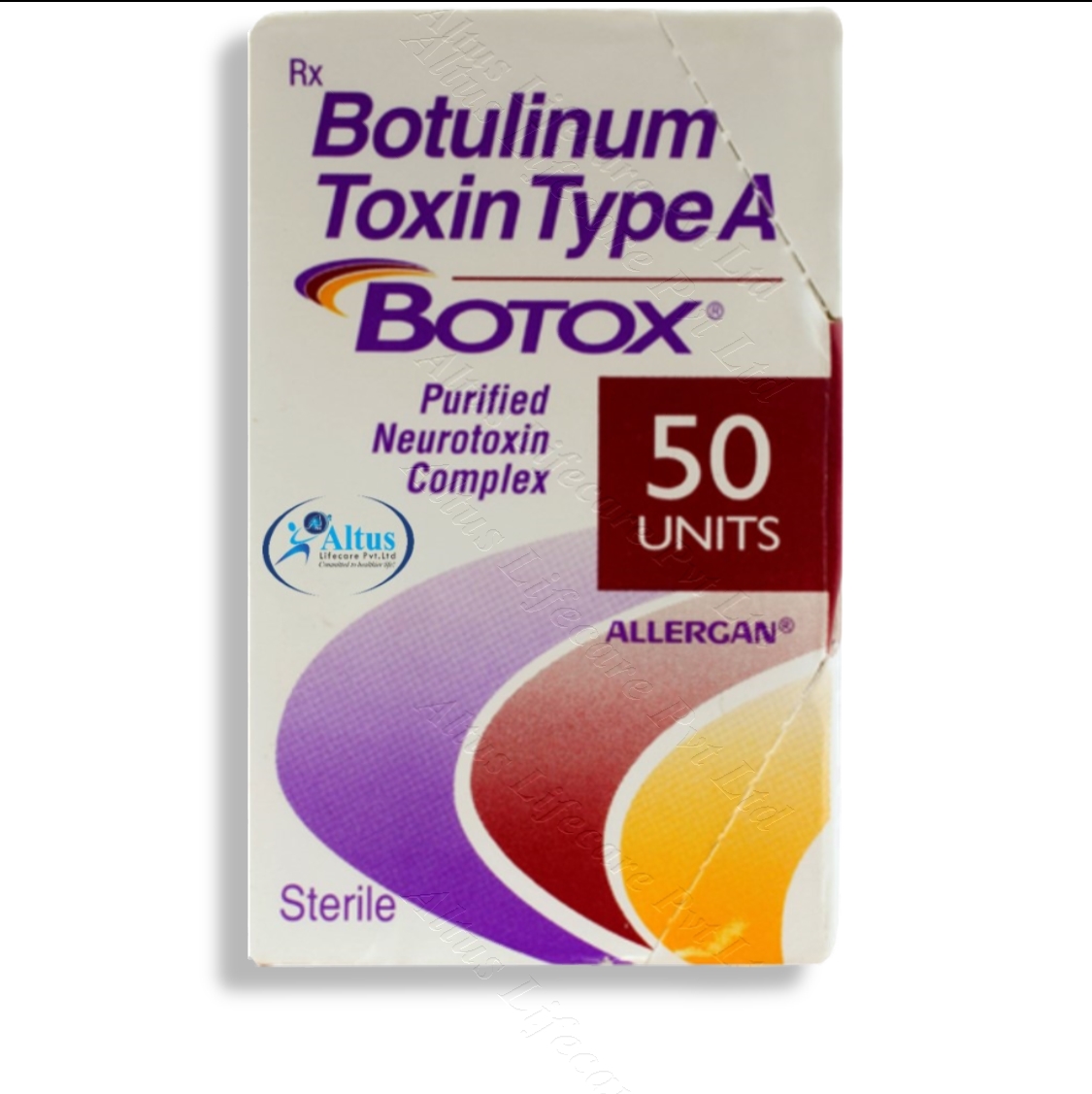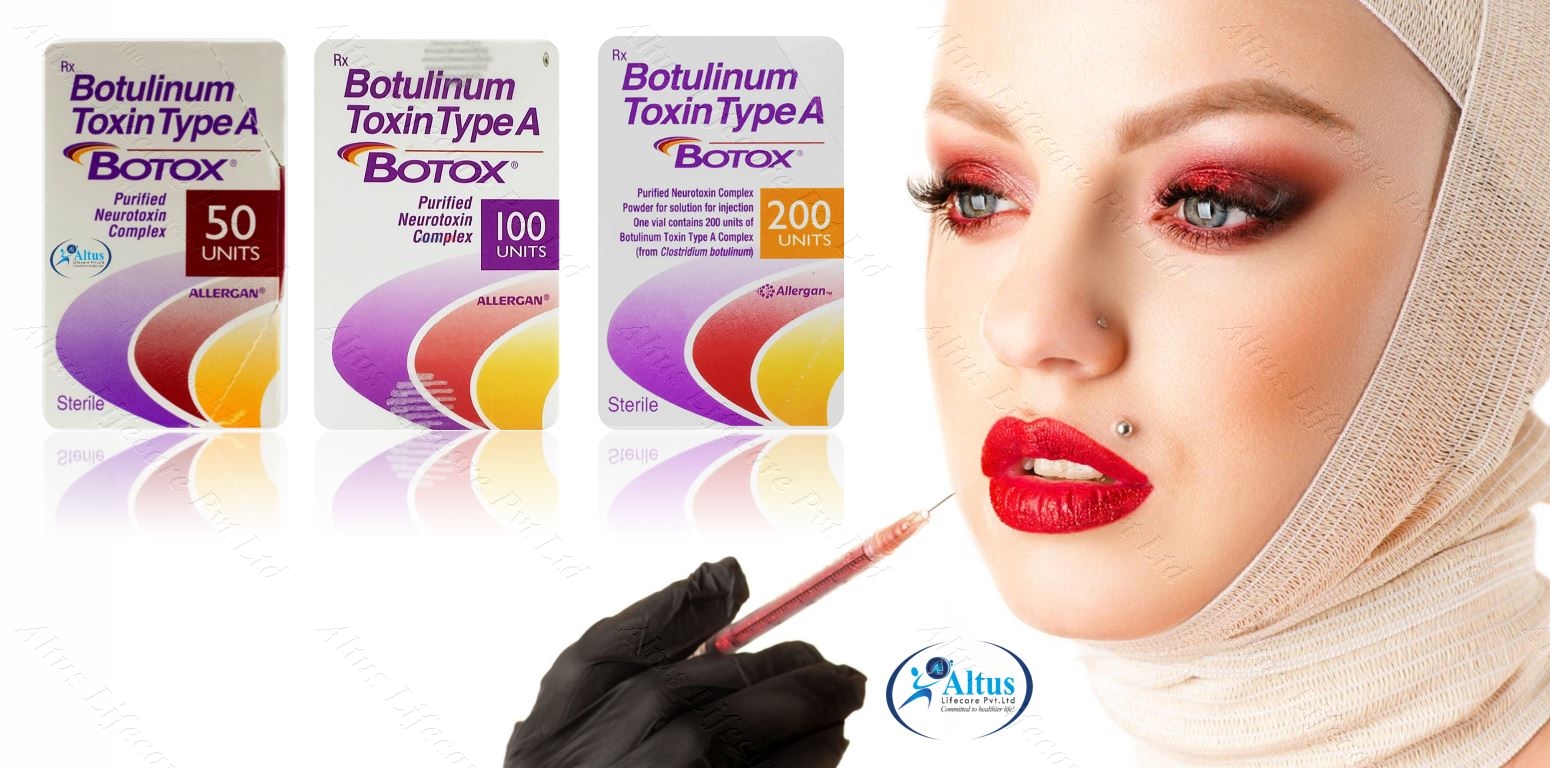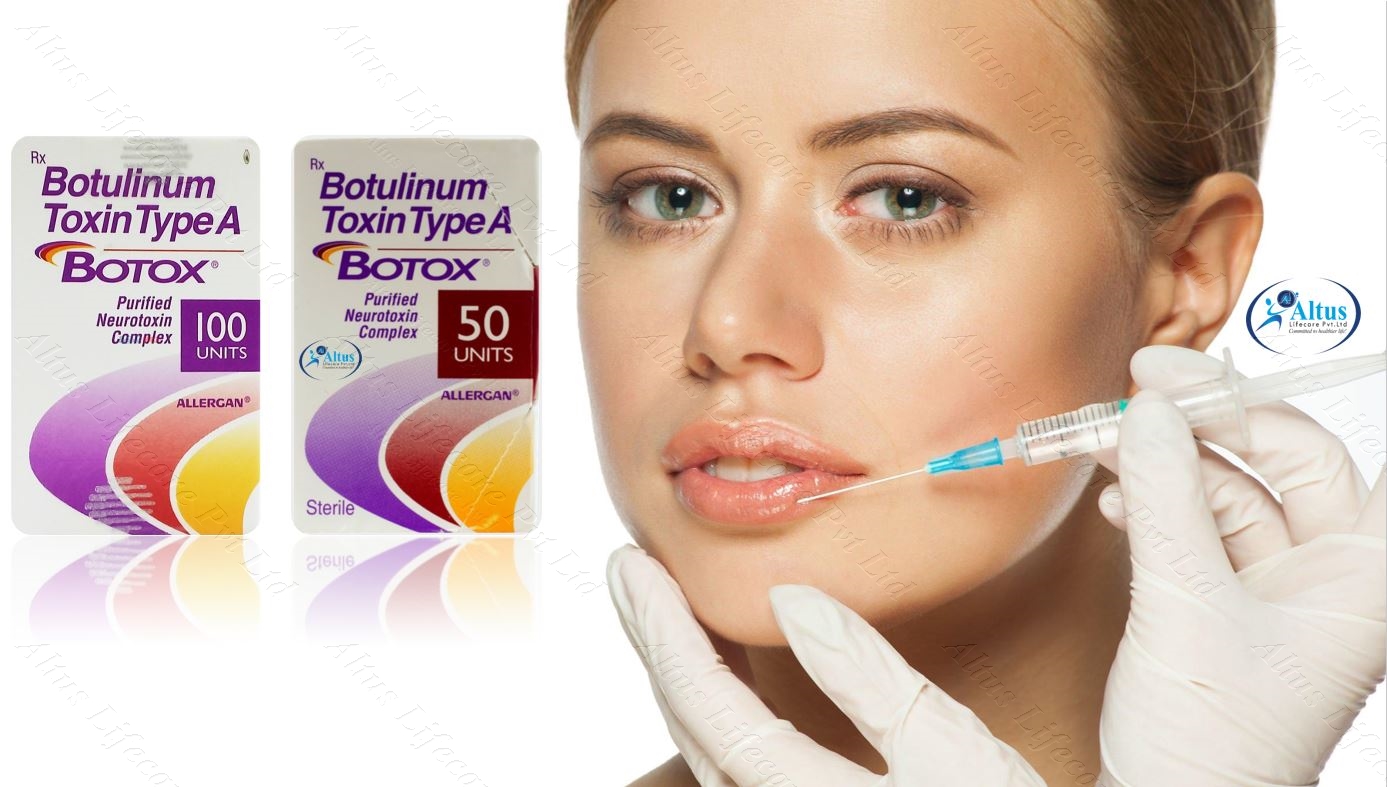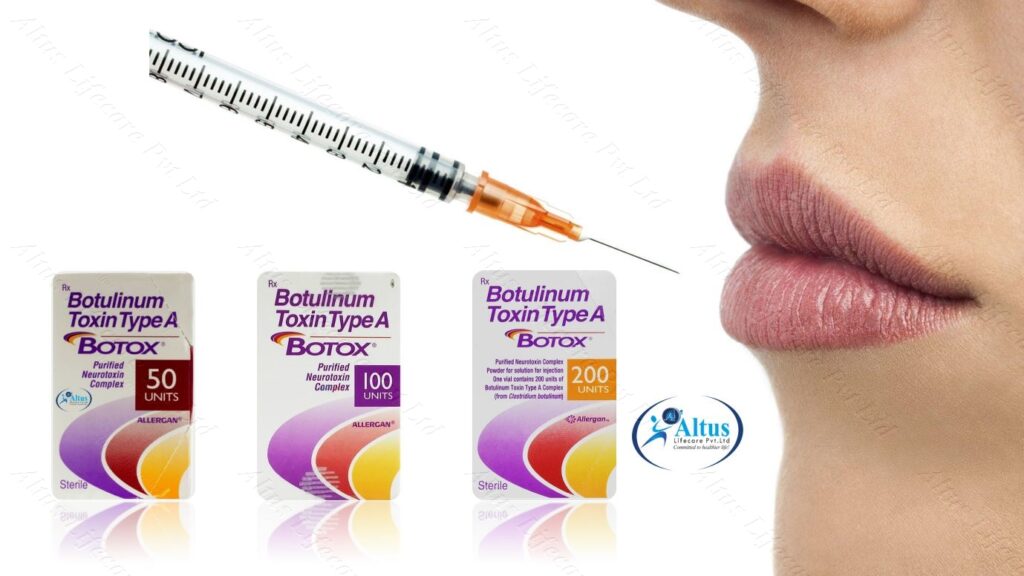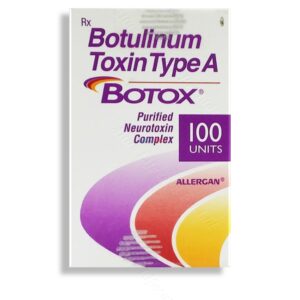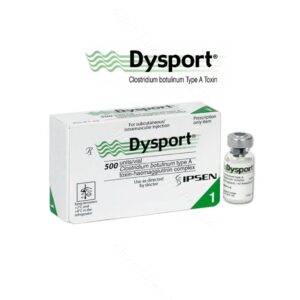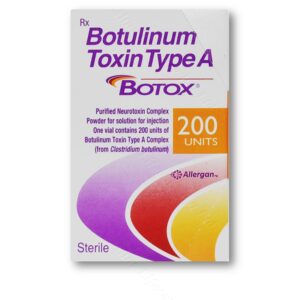Description
Botox 50IU Botulinum Toxin Type A
Botox (onabotulinumtoxinA), also called botulinum toxin type A, is made from the bacteria that causes botulism. Botulinum toxin blocks nerve activity in the muscles, causing a temporary reduction in muscle activity.
Botox is used to treat cervical dystonia (severe spasms in the neck muscles). It is also used to treat muscle spasms (stiffness) in the upper limbs (elbows, wrists, fingers) or lower limbs (ankles, toes). Botox is also used to treat severe underarm sweating (hyperhidrosis). Botox is also used to treat certain eye muscle conditions caused by nerve disorders. This includes uncontrolled blinking or spasm of the eyelids, and a condition in which the eyes do not point in the same direction. Botox is also used to treat overactive bladder and incontinence (urine leakage) caused by nerve disorders such as spinal cord injury or multiple sclerosis.
It is also used to prevent chronic migraine headaches in adults who have migraines for more than 15 days per month, each lasting 4 hours or longer. This medicine should not be used to treat a common tension headache.
Botox Cosmetic is used to temporarily lessen the appearance of facial wrinkles.
The Science Behind Bo tox: How It Reduces Wrinkles
Understanding the science behind Botox sheds light on how it reduces wrinkles effectively. Botox works by blocking nerve signals in the muscles where it’s injected. This temporary paralysis of the muscles prevents them from contracting, which is a key factor in the formation of wrinkles.
As a result, wrinkles and fine lines become less noticeable or even disappear. The science of Botox is a testament to its precision in targeting the root cause of dynamic wrinkles, making it a powerful tool in the field of aesthetic medicine.
Botox Injections Near Me: What to Expect from Local Botox Treatments
Botox injections near you offer a range of aesthetic benefits, from reducing fine lines and wrinkles to addressing various facial concerns. Knowing what to expect from local Botox treatments is crucial for setting realistic goals and understanding the process. We’ll delve into the science behind Botox, its effects, and the results you can anticipate when you choose a nearby clinic for your treatments.
The Mechanism of Action: How Botulinum Toxin Relaxes Muscles
The mechanism behind Botulinum Toxin’s muscle-relaxing effects lies in its ability to block nerve signals that stimulate muscle contractions. When injected into specific muscles, it disrupts the communication between nerves and muscles, causing temporary paralysis.
This process is key to reducing muscle-related issues, such as wrinkles in cosmetic applications and muscle spasticity in medical treatments. By interrupting the muscle’s ability to contract, Botulinum Toxin offers a non-surgical approach to achieving smoother, more youthful skin and managing a range of medical conditions.
Botulinum: Understanding Its Deadly Origins and Medical Applications
The origins of botulinum are indeed deadly, and it has a dark history tied to foodborne botulism. However, the toxin’s discovery has led to important medical applications. Botulinum’s role in medicine spans treating conditions like dystonia, muscle spasticity, and chronic migraines. It provides relief to individuals suffering from overactive muscles and neurological disorders, contributing significantly to the realm of neurology and muscle-related healthcare.
By understanding its lethal origins and the rigorous purification processes involved in medical and cosmetic applications, botulinum has evolved from a potential threat to a life-improving medical resource.
Understanding the Botox Injection Process: How It Works
The science behind Botox injections is a fascinating journey into the realm of cosmetic medicine. Botox works by blocking nerve signals in the muscles where it’s injected, temporarily inhibiting muscle contractions. These contractions are often the culprits behind dynamic wrinkles, like those that form when we frown or smile. The result is a smoother, more relaxed appearance.
The technique involves precision in injecting the right amount of Botox into the targeted muscles, and the procedure is typically quick and minimally discomforting. This science-driven approach is what makes Botox injections an effective and reliable choice for many individuals seeking to reduce facial wrinkles.
The Science Behind Masseter Botox: How It Reduces Jaw Clenching
Understanding the science behind Masseter Botox is essential to appreciate its efficacy in reducing jaw clenching and teeth grinding. Botox works by blocking nerve signals that stimulate muscle contractions.
When applied to the masseter muscles, it relaxes them, leading to a reduction in muscle activity. This not only alleviates the discomfort associated with jaw clenching but also has the aesthetic benefit of sculpting a slimmer jawline. The mechanism of action makes Masseter Botox a compelling option for individuals dealing with both medical and cosmetic concerns related to their jaw.
The Science Behind Botox in a Bottle: How Do Topical Formulas Work?
Understanding the science behind Botox in a Bottle is key to appreciating its potential efficacy. Topical formulas aim to relax facial muscles and reduce fine lines and wrinkles through the use of specialized peptides and ingredients.
These ingredients work at the surface level of the skin to target the same muscle-relaxing effect seen in injectable Botox. By applying these formulas as part of a skincare routine, individuals can experience a smoother, more youthful complexion, often without the discomfort or downtime associated with traditional Botox injections.
Important information
You should not use Botox if you have an infection in the area where the medicine will be injected. Botox should not be used to treat overactive bladder or incontinence if you have a current bladder infection or if you are unable to urinate (unless you routinely use a catheter). It contained in this medication can spread to other body areas beyond where it was injected. This has caused serious life-threatening side effects in some people receiving even for cosmetic purposes.
Call your doctor at once if you have a hoarse voice, drooping eyelids, vision problems, severe muscle weakness, loss of bladder control, or trouble breathing, talking, or swallowing. Some of these effects can occur up to several hours or several weeks after receiving a Botox injection.
Before I receive Botox
You should not receive Botox if you are allergic to botulinum toxin, or if you have:
an infection in the area where the medicine will be injected; or
(for overactive bladder and incontinence) if you have a current bladder infection or if you are unable to urinate and you do not routinely use a catheter.
To make sure Botox is safe for you, tell your doctor if you have:
amyotrophic lateral sclerosis (ALS, or ?Lou Gehrig?s disease?);
myasthenia gravis;
Lambert-Eaton syndrome;
a breathing disorder such as asthma or emphysema;
problems with swallowing;
facial muscle weakness (droopy eyelids, weak forehead, trouble raising your eyebrows);
a change in the normal appearance of your face;
bleeding problems;
heart disease;
if you have had or will have surgery (especially on your face);
if you have recently used a blood thinner (warfarin, Coumadin, and others) or been treated with an injectable antibiotic;
if you have ever received other botulinum toxin injections such as Dysport or Myobloc (especially in the last 4 months); or
if you have ever had a side effect after receiving a botulinum toxin in the past.
Botox is made from human plasma (part of the blood) which may contain viruses and other infectious agents. Donated plasma is tested and treated to reduce the risk of it containing infectious agents, but there is still a small possibility it could transmit disease. Talk with your doctor about the risks and benefits of using this medication.
Uses of Botox 50 Injection
What is it prescribed for?
- Muscle spasticity
This medicine is used for the treatment of muscle spasticity (a condition of muscle stiffness and tightness) of upper and lower limbs (arms and legs) in adult patients. It is also used for the treatment of muscle spasticity of upper limbs (arms) in pediatric patients.
- Blepharospasm
This medicine is used for the treatment of abnormal contraction of the eyelid muscles or eye twitching that occur due to nerve disorders.
- Cervical Dystonia
This medicine is used for the treatment of cervical dystonia, also known as spasmodic torticollis, which is a painful condition where the neck muscles contract involuntarily, causing your head to twist or turn to one side.
- Overactive Bladder
This medicine is used for the treatment of overactive bladder with urinary incontinence, urgency, and frequency in patients who have shown an inadequate response to or cannot use anticholinergic medications.
- Facial lines
This medicine is used for the treatment of moderate to severe vertical lines between the eyebrows (glabellar lines), moderate to severe lateral canthal lines (crow’s feet lines), and moderate to severe forehead lines seen at maximum eyebrow elevation.
- Chronic migraine
This medicine is used for the prevention of severe throbbing headaches in adult patients.
- Strabismus
This medicine is used for the treatment of strabismus or crossed eye, an eye condition where the eyes do not properly align with each other and point in different directions.
- Hyperhidrosis
This medicine is used for the treatment of excessive sweating in patients who have shown an


